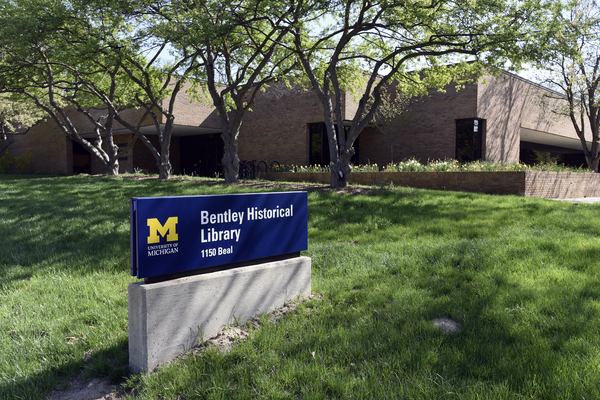
Search Constraints
Start Over You searched for: Repository University of Michigan Bentley Historical Library ✖ Remove constraint Repository: University of Michigan Bentley Historical Library Subjects Surveyors -- Michigan. ✖ Remove constraint Subjects: Surveyors -- Michigan.Search Results
5 linear feet
The Camp Davis record group documents the summer camps for training students in the techniques of surveying and geodesy conducted by the College of Engineering's Department of Geodesy and Surveying. The bulk of the material concerns Camp Davis and Jackson Hole, Wyoming but also includes material relating to earlier camps at Douglas Lake and other sites in Michigan. The records are organized in five series: Histories; Michigan Engineering Camp, Early Sites, 1874-1912; Bogardus Engineering Camp, Douglas Lake, Michigan, 1906-1929; Camp Davis, Jackson, Wyoming Site, 1929-; and Photographs.
0.4 linear feet (1 box) — 2 oversize volumes — 3 oversize folders
The Douglass Houghton manuscript collection at the Michigan Historical Collections includes one volume of field notes, 1837-1841; typed transcripts of the field notes; a one volume letterpress book, 1841-1845; miscellaneous correspondence, newspaper clippings and other papers (photostats and typescripts of materials in other repositories); and notes collected by Mrs. John Ehlers for a book on Houghton.
An appendix to this finding aid contains an inventory to the manuscript maps found in the collection, and other Houghton maps.
The reports of Houghton's work for the Michigan Geological Survey have been published in Geological Reports of Douglass Houghton: First State Geologist of Michigan, 1837-1845, Lansing, Mich.: Michigan Historical Commission 1928. [MHC call number EA/153/MG345/G345, available online through HathiTrust]
Douglass Houghton Papers, 1829-1845
0.4 linear feet (1 box) — 2 oversize volumes — 3 oversize folders
1 linear foot — 1 microfilm
The George Cannon collection consists of letters, a journal, historical essays written for the Macomb County Historical Society, and various land records, including some surveying notes. Most of the letters were received by Cannon or other members of his family. There is in these letters much documentation relating to the Upper Peninsula and to the history of the settlement of Macomb County. Of especial interest are those letters and documents relating to the border dispute between Wisconsin and Michigan (particularly in the period of the first decade of the 20th Century) arising out of a surveying error in the 1830s. Many of the letters are from Upper Peninsula businessman and University of Michigan Regent Peter White.
Other items of interest are essays and lectures of the students who attended the Stony Creek Lyceum Rochester School where Cannon taught in the 1840s, a few Civil War letters from his brother Levi Cannon who served with Co. B of the 22nd Michigan Infantry, and essays Cannon wrote on his surveying mentor William A. Burt and on the early settlement of Macomb County.
0.7 linear feet
The John Harris Forster papers are arranged in seven series. Correspondence primarily contains letters written by Forster to various family members, and is arranged chronologically by year. The Thomas Forster series contains materials of John's father, chiefly correspondence and documents pertaining to family and financial matters. Journals and Manuscripts is arranged by year, with titles provided on the contents list. Scrapbook Materials consist of clippings from various newspapers (most of which are unidentified). Forster evidently was a journalist correspondent for these papers, and his columns seem to be excerpts from his journals, with slight modification. His Speeches and Addresses to various Michigan organizations also are based to a large extent on his journals, but there are exceptions, such as the very interesting one detailing life as a Swine-herd in California. Miscellaneous consists mostly of biographical materials and financial documents. Photographs includes portraits and view of the family farm near Williamston, Michigan. For related materials on Forster, including biographical clippings, correspondence to his wife, family documents, and other Forster writings, the researcher should consult the Mullett Family Papers.
101 oversize volumes — 69 oversize folders (in 20 boxes)
The records originally came from two sources. Volumes 1-51 and 78 to 87 (tract books for the Lower Peninsula) and the outsize folders (Lower Peninsula plat maps) are copies of earlier records made in 1894 for the Grayling Land Office. When that office was closed in 1898 the records were transferred to the Marquette Land Office. Volumes 52-77 and 88 (tract books for the Upper Peninsula) and volumes 150A-161 (plat maps for the Upper Peninsula) are the original records kept in the Marquette Land Office (originally in Sault Ste. Marie) beginning in 1847.
The records were transferred to the General Land Office in Washington, D.C., when the Marquette Land Office was closed in 1925. In 1940, the Auditor General of Michigan, who was the chairman of the Michigan State Land Office Board, accepted the records for the state. (The State Land Office Board was established in 1937, and was not related to the Michigan State Land Office, which was abolished in 1914 and replaced by the Public Domain Commission.) Because of crowded conditions in the State Capitol, the Auditor General asked that the records be deposited in the Michigan Historical Collections, where they could be used by a WPA Writers Project study of the disposal of public lands in Michigan. They have been on deposit at this library since that time.
Michigan State Land Office Board records, 1816-1924
101 oversize volumes — 69 oversize folders (in 20 boxes)
1 linear foot — 1 oversize folder
The Mullett family collection contains many useful descriptions of the state, and is a good source of information for some of the state's economic and topographic conditions during the 19th century. The papers, 1825-1936, are broken down into four series.